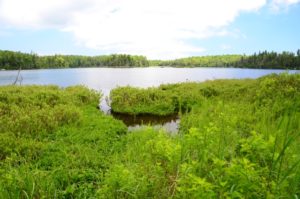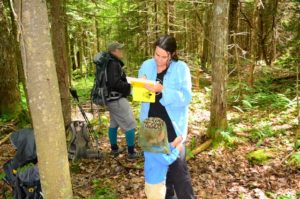 Distance from Nearest Road: 2.6 miles
Distance from Nearest Road: 2.6 miles
Distance from Nearest Hiking Trail: 0.8 miles
Travel Method: Hiking
Travel Distance One-Way: 4.5 miles
Cell Phone Coverage: Yes
Public Land: Yes, Lye Brook Wilderness Area within Green Mountain National Forest
Project Remote is working to precisely calculate and travel to the remotest locations in each of the 50 United States. Below is a written account of our 1-day hiking expedition to document the Vermont Remote Spot. This is our 15th state Remote Spot documented as part of Project Remote.

We begin our day-hiking foray to the remotest location in the entire state of Vermont within Green Mountain National Forest…starting at the Bourne Pond trailhead. This will be an out-and-back hike featuring what appears to be our longest off-trail bushwhack (through intact forest) on Project Remote to date.

Excitement is running high. The first part of the trail into Bourne Pond has boardwarlks through wet bog habitat. Although we appreciate the protection of the bog and not getting our feet wet, there is something about trail development that detracts from having a wild experience. At least it’s a trail and not a road. Trails good. Roads bad. Trails facilitate people getting outdoors, excercising and experiencing nature. Roads scar the landscape (at least 15 different impacts) and facilitate more fossil fuel burning.
One of the many sensational sights along our hike into Bourne Pond. This is a large adult female American toad (Bufo americanus). She is spectacularly camouflage. We didn’t see her in the trail until she hopped.
 About 2 miles into our hike, we enter the Lye Brook Wilderness. According to www.wilderness.net, which is the nation’s premiere website to learn about our national wilderness heritage, the Lye Brook Wilderness contains about 18, 122 acres of northern hardwood forest, spruce thickets, and wetlands all within the rolling hilly terrain of the Green Mountains. Lye Brook was established in 1975 by the National Wilderness Preservation System as stipulated by The Wilderness Act of 1964. The Wilderness Act was created by visionary conservation advocates and legislators with the intention of protecting large wildlands from roadbuilding and municipal development.
About 2 miles into our hike, we enter the Lye Brook Wilderness. According to www.wilderness.net, which is the nation’s premiere website to learn about our national wilderness heritage, the Lye Brook Wilderness contains about 18, 122 acres of northern hardwood forest, spruce thickets, and wetlands all within the rolling hilly terrain of the Green Mountains. Lye Brook was established in 1975 by the National Wilderness Preservation System as stipulated by The Wilderness Act of 1964. The Wilderness Act was created by visionary conservation advocates and legislators with the intention of protecting large wildlands from roadbuilding and municipal development.

If America’s national parks are our nation’s “best idea,” then we submit that the Wilderness Act of 1964 is our second best idea. Actually, we believe that the Wilderness Act probably is the better idea of the two…There is no greater thing that a continually expanding and developing country can do for itself than to set aside by law vast amounts of its lands to be protected from human development forever. The Wilderness Act may be the strongest piece of legislation ever created by any country to preserve wildlands. Remote Footprints’s ideals and beliefs are perfectly in line with Wilderness Act guidelines. But we wish to simplify by saying–“No more roads.”
 We approach the south side of Bourne Pond. There is a sizeable spread of open water in the interior of the wetland while its shores are blanketed by lush marsh.
We approach the south side of Bourne Pond. There is a sizeable spread of open water in the interior of the wetland while its shores are blanketed by lush marsh.

We spot a spectacular pitcher plant in bloom within the emergent marshy vegetation. Pitcher plants are “carnivorous,” because they actually can “eat” animals. They don’t actively hunt and subdue prey. But they do trap small prey items, usually insects, inside their pitcher-shaped modified leaves. An insect is attracted by an irresistable smell, then it falls down into the upright “pitcher” never to climb back out the unscalable walls. It dies an gets absorbed by the plant walls. Plant trickery of the animal kingdom…
 We lunch at Bourne Pond. This is a great opportunity for Skyla to get out of the backpack and explore the natural world around her. She continues to be amazed by plants, especially colored flowers.
We lunch at Bourne Pond. This is a great opportunity for Skyla to get out of the backpack and explore the natural world around her. She continues to be amazed by plants, especially colored flowers.

Before we began Project Remote, we thought we’d have to do a whole lot more of this type of overland travel to get to our calculated Remote Spots. It just hasn’t been the case. However, today’s bushwhack off trail to the Vermont Remote Spot is the longest non-coastal, off-trail walk we have had to do so far in the entire eastern United States – 0.8 miles off the foot trail to be exact. The forest and understory composition are variable. We crash through hobblebush thickets and waft bug clouds. We notice 4 types of bugs pestering us–tobanid horse/deer flies, mosquitoes, no-see-ums, and of course blackflies. This tests our patience and stamina. It takes 1.5 hours for us to travel the otherwise short, but difficult distance to the Remote Spot.

In the early afternoon, we arrive at the Vermont Remote Spot. The understory here is much more open than the thickets we pushed through to get here. The photo at right is a southward view from the Vermont Remote Spot.

There is much to be done with little time. Plus, the bugs worsen when you stop moving. We waste no time doing our documentary work. It’s 2 pm and we don’t want to arrive back at our parked vehicle after dark. So, we conduct the Remote Spot Assessment (RSA). The object of our RSA is to measure the extent to which humanity can be detected from any given Remote Spot. This knowledge will help us to determine if there are places remaining in the United States that a person can go to have a true wilderness experience isolated from the effects of human development. RSA data also will serve as baseline information on remoteness of the U.S. in the early 21st century. Unfortunately, during the RSA, we faintly hear the distant hum given off by auto traffic on Route 7, which is located over 2 miles to the west of the Remote Spot. It blows our minds that you can hear cars for over 2 miles. Brings back memories of Arkansas…Our wilderness experience is impacted by the noisy road. It’s not good for either humans or wildlife when major roads border wilderness areas. Noise pollution can penetrate to the center of what most people would agree are “large” wilderness areas. We believe that not only must we preserve larger roadless wildlands, it also is important that existing wilderness areas be buffered from major roads and development.

The RSA always takes longer than expected. Skyla needs some attention and we must break to provide our young daughter of three years some TLC. She has done amazingly for many days now constantly on the move, but suffers a long overdue meltdown on the Vermont Remote Spot. The remotest child meltdown in all of Vermont.


Except for the audibility of Route 7 from the remotest location in Vermont, it would appear that the Vermont Remote Spot has excellent prospects for continued preservation, since it resides within a national Wilderness Area. This sort of juxtaposition of wildlands and developed lands has become a 21st Century reality. The best answer, still, is to save all that is left. And stop encroaching on our remaining roadless areas. Simply put, “no more roads.”

After reading this website, you might be surprised at just how hard it is to get away from a road or a town nowadays–and instantly understand that we must now as a nation speak out to protect remaining public roadless areas from further roads development. Project Remote is now over half-way done! Our goal is to raise enough funding simply to offset the cost of traveling frugally state by state, completing the documentary field work, and maintaining this website. If you like what we do, please make a donation to support Project Remote today. Thank you so very much for helping us to preserve remote America…
–The Remote Spotters
